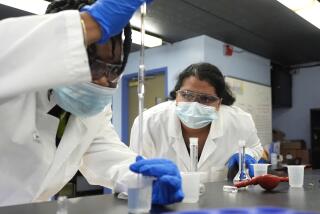250-Gallon Tank Helps : In Kenya, Water Is Key to Health
- Share via
ELORET, Kenya — They had chosen this spot because it had one of the newest schoolhouses, so all the Masai parents with young children would know the place. Just before noon, more than 100 men, women and children from the district had gathered, sitting on the brown dust under an acacia tree. Three Brahman calves from somebody’s herd ruminated at the edge of the crowd.
About 20 schoolchildren in dusty blue uniforms with red and pink trim prepared to sing their song of karibu , or “welcome.” A group of Masai women ranging in age from 19 to 40, wearing long, articulated wire earrings and red-striped and -checked wraps that resembled tartan in their variety, would follow with a dance and song in praise of Kenyan President Daniel Arap Moi.
Many Were Sick
There would have been more people, said one of the district councilors, standing to address the crowd in his red-checked shirt, but many were sick.
“Mostly malaria,” whispered Dr. Matheke Mwololo, the local public health officer. “At this time of year, after the rains, we see malaria among the Masai tribe go like this.” He used his hand to describe a sharply rising curve.
The ceremony was to dedicate the district’s most important medical acquisition in years--perhaps ever. Bought with $2,300 in artfully applied population-control funds, it stood off to one side, its trailer hitch perched delicately on a rock: a mobile 250-gallon water tank.
For in this region, a plain of low grass and scrub stretching from south of Nairobi to the Tanzanian border, the alpha and omega of health care is water.
A Two-Fold Enemy
As a product of nature, it is an enemy as much in times of abundance as scarcity. In the rainy season it comes in flash floods. When the floods recede, drinking from the remaining ponds and rivulets means courting the vomiting and diarrhea caused by a great variety of parasites.
Although the local doctors do not recommend it, the people gather rainwater to drink by placing barrels under the corrugated eaves of the few buildings that exist. Even this water, as clean as any that is accessible from nature, is never enough to last through the months of unimaginable heat following the rains.
“Even if that road over there were under three feet of water during the rains,” said Dr. Moses Okech, “there wouldn’t be enough clean drinking water for these people.”
As head of the hospital built about six miles down the road by the Magadi Soda Co., a British concern that extracts sodium carbonate from the pink-tinted Lake Magadi to manufacture glass, Okech is responsible for the health care of the residents in an area with a 25-mile radius. That area includes more than 6,000 people in the company town of Magadi, and as many as 15,000 more, mostly nomadic Masai cattle- and goat-herders, in the bush.
If overspecialized Western doctors are only now rediscovering the need to treat the whole person, in Africa doctors like Okech and Mwololo have long understood the need to treat the whole ecology. For any deficiency, whether of water, vitamins or protein, can manifest itself in the population through a range of serious maladies.
Creative Request
The two doctors applied that lesson in January, when they first made a creative request to the Family Planning Private Sector program. Distributing money from the U.S. Agency for International Development (AID), FPPS was funding a birth-control program in which Magadi Hospital doctors and nurses were to introduce contraceptives, not to mention the very notion of family planning, to the Masai women in the bush.
Family planning is one of Kenya’s top priorities, for its population growth rate of nearly 4% a year, one of the highest in the world, is placing an intractable strain on the nation’s resources. But Okech and Mwololo found that until they could raise the Masai population’s general health standards to some minimum level, there was no point in talking about birth control.
“We discovered we couldn’t just talk about family planning, but we had to take up infant mortality and prenatal health as well,” Okech said. “We had to make the women feel that if they attended prenatal clinics, they wouldn’t just be given family-planning lectures.”
“They told us that the best contribution we could make to family planning in the area was a water tank,” recalled Joan Robertson, the program coordinator for FPPS. She paused. “It was a pretty far-out request. I told them they’d better put it in writing and I’d see what we could do.”
Signs of Dehydration
What was most striking about the women and children whom Okech and his staff saw in the hospital and on their trips into the field were the characteristic signs of dehydration: dry skin, sunken eyes, general weakness and bloated bellies.
Dehydration is simple enough to treat: Oral rehydration salts are available over the counter everywhere in Africa. But the women explained to the Magadi doctors that they had no clean water in which to mix the tablets.
The water crisis resounded through the population like the tolling of a bell; in some way it was behind every health problem that the doctors saw. It contributed to the malnutrition and anemia of the women, already malnourished and weak from chronic poverty and a scarcity of protein.
The women would pass the same deficiencies on to their infants, so that any health crisis the babies suffered would be magnified. Malaria, seasonal and endemic in the semi-arid region, was one of the most threatening. The poor condition of the Masai infants forced the doctors into a drastic malaria therapy: blood transfusion. The age of the patients and the inadequate screening of blood for AIDS, or acquired immune deficiency syndrome, and other diseases, make this a hazardous treatment at best.
Health Complications
“You take a child with malnutrition and anemia,” Mwololo said after the dedication ceremony, as he guided some visitors through the pediatrics ward of the Magadi Hospital. “One bout of malaria before the age of five months and boom--that takes care of what little blood they have left.”
The crisis in the quantity and quality of water more directly affects the local infant mortality rate, which Mwololo and Okech estimate at close to 110 per 1,000. It is responsible for a chronic environment in which the largest single contributor to infant mortality is gastroenteritis.
“We’re aiming to strike directly at gastroenteritis with this water tank,” Mwololo said.
In Africa, relief agencies must be flexible. Robertson saw the Magadi doctors’ point. She brought the matter to the local AID mission, which eventually approved it. In the end, $2,300 bought the gray water tank on wheels that now stood by the side of the Eloret acacia, inscribed in black paint: “Dedicated to the children of Magadi district.”
Four Trips a Day
The tank had already been in use for several weeks, filled with already purified water from Magadi’s municipal system and making as many as four trips a day throughout the district. At points along the road, a two-lane Tarmac maintained by Magadi Soda, groups of Masai women waited patiently by piles of gallon cans and plastic jugs.
Meanwhile, Joel Sayunga, a youthful and forward-looking chief whose hereditary standing among his tribe has been turned into a district administrative office by the government, stood up in his immaculate khaki uniform. A badge with “Chief” inscribed in red cloisonne was pinned to his shirt.
“Parents might think that the doctors come here only for family planning,” he told the crowd. “But that is not true. They also come here for family maintenance.”
The Masai presented Robertson with one of their beaded, parti-colored necklaces. And then, as women and children armed with metal cups and water gourds crowded around, she opened the spigot.
More to Read
Sign up for Essential California
The most important California stories and recommendations in your inbox every morning.
You may occasionally receive promotional content from the Los Angeles Times.










